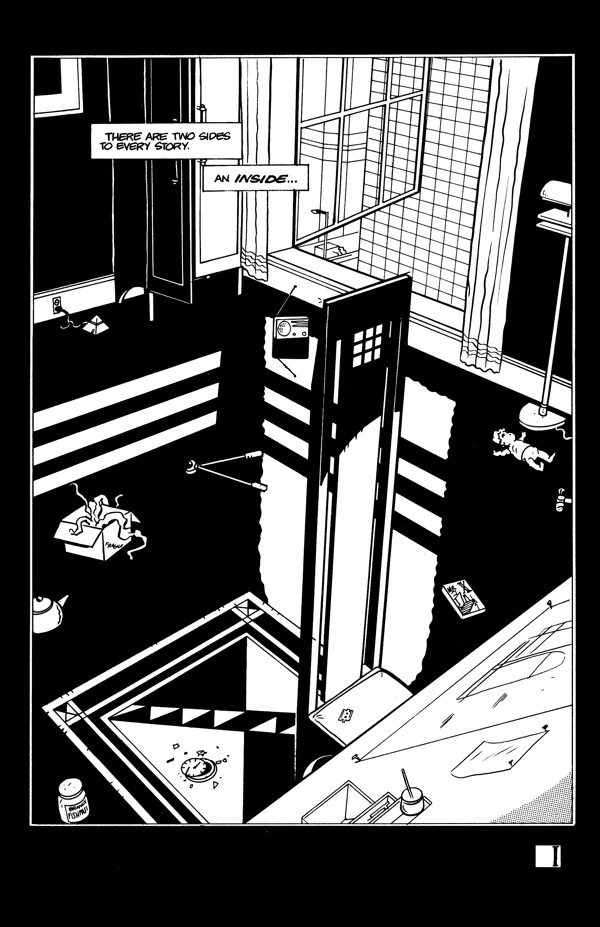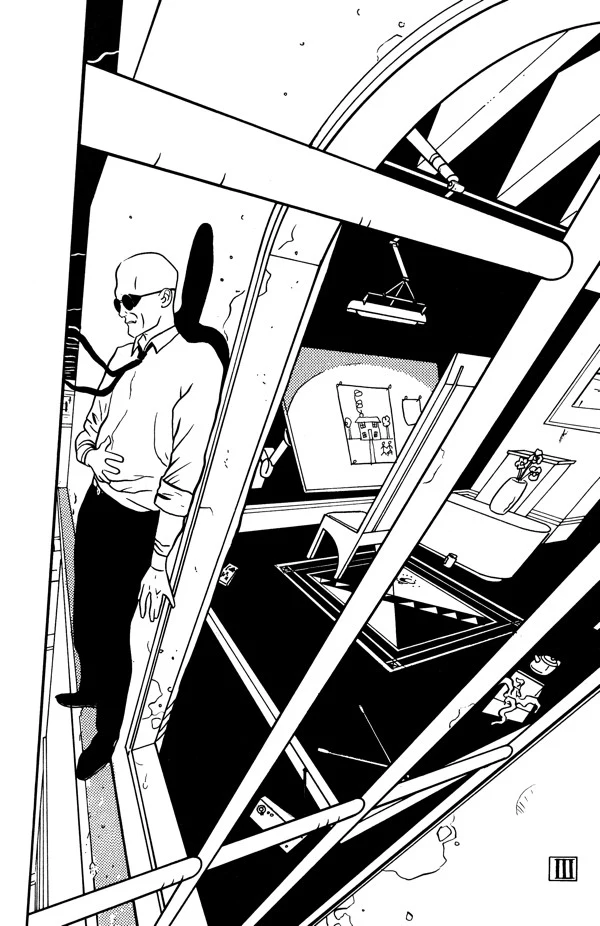
Comics We Love: ‘Mister X’ and Its Retrofuturistic Architecture of Madness

Dark Horse continues its efforts to revive the long-out-of-print Mister X comics in June with Dean Motter's Mister X: The Brides of Mister X and Other Stories, the second massive hardcover collection of the series that got about a dozen all-star careers started, married sequential art with the principles of design, and drastically altered the way comics looked.
You might never have heard of Dean Motter's Mister X. You might be so young and mainstream as to have never even read a black-and-white comic. (Laugh if you want, these people are out there.) But whether you realize it or not, you've been seeing signs of Mister X's presence in so much of what you read that you've practically been raised on the mad bastard....For me, the golden age of comics will always be the 1980s. I know that statement officially makes me an idiot, but keep reading: There's more idiocy where that came from. Technically, I know, it's considered the modern age, or the dark age. My view of the eighties as the golden age probably has a lot to do with growing up in that generation -- like when politicians refer to the "simpler times" they grew up in, except I'm not a liar, and nothing is ever simple. The 1980s are the decade in which comic books took giant steps. When the perpetual adolescent grew up and moved out of his parents' basement to look for a place of his own. When comics decided they were cool.
 Dean Motter had a lot to do with that. Though he'd had some experience in comics and illustration, he was most known for his design. As the art director for the Canadian division of CBS records, Motter had a hand in the creation of some memorable album art, including Loverboy and Anvil. (1980s weren't so much of a golden age, musically). In the early eighties, Motter unconsciously created Mister X while doing jacket illustration for house music forebear Patrick Cowley's Megatron Man. The cover was better than the song, by the way.
Dean Motter had a lot to do with that. Though he'd had some experience in comics and illustration, he was most known for his design. As the art director for the Canadian division of CBS records, Motter had a hand in the creation of some memorable album art, including Loverboy and Anvil. (1980s weren't so much of a golden age, musically). In the early eighties, Motter unconsciously created Mister X while doing jacket illustration for house music forebear Patrick Cowley's Megatron Man. The cover was better than the song, by the way.
The character was so visually striking, he stuck with the illustrator and eventually made it into a potential project he'd been bouncing around with another designer/illustrator, Paul Rivoche. Working in animation, poster art, and magazine illustration, Rivoche brought meticulousness, craftsmanship, and a love for noir, art deco, and Bauhaus that mirrored Motter's own. Over the course of a year, the two roughed out the concept of Mister X and the world he inhabited. And brother, it's a weird one.
Radiant City was built to be a paradise, a city of dreams. A metropolis founded and forged on principles of aesthetic beauty that would enrich and inspire its denizens. Instead, it became a city of nightmares --- an unforeseen result of the "psychetecture" designed to enhance the residents' states of mind. Instead of a city of thinkers and dreamers, Radiant City fostered mental illnesses, manias, and mass psychoses. All of its citizens suffered from the flaw in its construction, and crime and corruption were rampant. An epidemic of sleeping sicknesses and delusions plagued the entire population, and the city came to be known as Somnopolis.
 Against this dark backdrop of false art deco angles and skewed geomancy, Mister X emerges. Much more than just a stock vigilante or night detective, Mister X is a murderer, a terrorist, a clinically insane man who takes a drug called insomnalin so he never has to sleep. He claims to be one of the original architects of Radiant City, and for twenty-four hours a day he plots to correct the fatal flaw in his own creation, bringing him into conflict with crooked politicians, psychotic mob bosses, and ex-girlfriends.
Against this dark backdrop of false art deco angles and skewed geomancy, Mister X emerges. Much more than just a stock vigilante or night detective, Mister X is a murderer, a terrorist, a clinically insane man who takes a drug called insomnalin so he never has to sleep. He claims to be one of the original architects of Radiant City, and for twenty-four hours a day he plots to correct the fatal flaw in his own creation, bringing him into conflict with crooked politicians, psychotic mob bosses, and ex-girlfriends.
Before Motter and Rivoche completed any comics, though, they suffered a philosophical split and parted ways on the project. Rivoche continued to provide a few covers, and the pair collaborated on other projects, but they simply couldn't come to terms over Mister X. Motter did some straight scripting for large portions, and wrote and illustrated a few stories over the years, but for the most part Mister X was farmed out to an impressive list of creators. For the first volume, the Hernandez Brothers, Gilbert, Jaime, and Mario came in to produce the book under Motter's story outlines and art direction. After they departed, Motter took over full scripting, with art from singularly named indie luminary Seth.
For the second volume in 1989, the bulk of The Brides of Mister X, Motter recruited stark, black-and-white art from highly overlooked Shane Oakley and another singularly named indie luminary, D'Israeli. The twelve-issue story was scripted by Jeffrey Morgan, a writer whose main experience took place in the much cooler area of rock and roll journalism. As a writer and editor for CREEM, Morgan hung out with the likes of The Stooges while learning from the most accomplished prose stylist of the magazine trade, Lester Bangs. Overall, it's a much darker take on the themes and characters than the first volume, carried off in a style that's strangely reminiscent of the music of the Berlin period of David Bowie, Lou Reed, and Iggy Pop. No, really.
 Mister X remains one of the most influential comics of comic books' second most influential decade. The list of artists and writers captured by its unique vision is an impressive one that leaps mediums, genres, and generations. Its odd concoction of retro futurism, art deco and noir inspired a wide group of writers and artists alike: Alan Moore, Neil Gaiman, Dave McKean, Scott McCloud, Chris Sprouse, Gene Ha, Tony Harris, Paul Pope, and many more than my embattled brain could ever recall.
Mister X remains one of the most influential comics of comic books' second most influential decade. The list of artists and writers captured by its unique vision is an impressive one that leaps mediums, genres, and generations. Its odd concoction of retro futurism, art deco and noir inspired a wide group of writers and artists alike: Alan Moore, Neil Gaiman, Dave McKean, Scott McCloud, Chris Sprouse, Gene Ha, Tony Harris, Paul Pope, and many more than my embattled brain could ever recall.
Motter and Rivoche's vision even went on to influence films, including Tim Burton's Batman, The Shadow, Dark City and Brazil. Magazine and album illustration weren't immune; Paul Rivoche was heavily involved in crafting the look of Batman: the Animated Series, and it and several over cartoons have dabbled in the design concepts Mister X propagated. It was the first thing that looked this way, regardless of medium. An innovator.
Mister X continues to live on, not just in Dark Horse's impressive collections. In 2008, Motter wrote and drew Mister X: Condemned, a sort of reboot of the character, a cementing of concept and continuity, and though it didn't necessarily sell like gangbusters, it looked and read the part. According to Motter's website, there's a forthcoming volume of new story, Mister X: Evicted, set for release in 2012. For now, we have to settle for big, fat, impressive slabs of innovation that, like retro-futurism, take one step back while still looking forward. That's not so bad. Weren't you reading?
Preview of Brides of Mister X, via Dark Horse Comics:









More From ComicsAlliance



![Groo, Goon, And Horror For All Ages In Dark Horse’s NYCC 2014 Announcements [NYCC]](http://townsquare.media/site/622/files/2014/10/GrooMain.jpg?w=980&q=75)



![Dark Horse Bringing Gustavo Duarte’s ‘Monsters! & Other Stories’ To America In January [Preview]](http://townsquare.media/site/622/files/2013/08/duartemaos.jpg?w=980&q=75)

